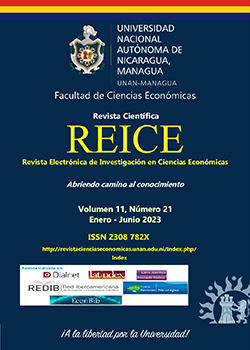Restoration of urban architectural complexes: dynamics of visual images, urban marketing, and tourism development
DOI:
https://doi.org/10.5377/reice.v11i21.16545Keywords:
restoration, architectural complex, visual image, urban marketing, tourism developmentAbstract
This article aims to explore the intricacies of urban architectural complex restoration and the dynamics of visual images, with a focus on analyzing urban marketing and tourism development. The process of environmental design has enabled the adjustment of urban environments, following its theoretical substantiation. This substantiation has facilitated the formulation of a methodology for adjustment, allowing for the development of a sequence and content of design actions, as well as the logical integration of this methodology into the architectural design system. Furthermore, this article substantiates the concept of a visual image of the environment as a product of the visual perception of urban environments. This concept is responsible for forming a certain aesthetic, spiritually rich image of the urban environment with its intrinsic qualities of temporal and spatial dynamics within the minds of individuals. The present article provides an analysis of domestic and foreign research on the visual perception of urban environments, revealing that it encompasses three interrelated aspects: psychophysiological, aesthetic, and artistic-figurative. Notably, studies on the daily dynamics of urban environments are scarce, despite the increased activity of life processes during the day, which necessitates greater consideration in design practice. To address this, we selected three fragments of the historical centers of Lviv and Bishkek as our study areas. Our investigation confirmed the need for a radical transformation of the urban environment. Combining professional analysis of the urban environment with sociological research, we developed a methodology for adjusting these fragments to create comfortable and informative environments with specific artistic and aesthetic advantages, utilizing environmental design and monumental and decorative art. Additionally, we substantiate the role of this urban environment adjustment technique in the broader stage system of architectural design for project development and implementation.
Downloads
References
Prokopenko, O., & Kornatowski, R. (2018). Features of modern strategic market-oriented activity of enterprises. Marketing and Management of Innovation, XIV (I), pp. 165–173. http://doi.org/10.21272/mmi.2018.1-22
Aasen, C. T. (1998). Architecture of Siam: A Cultural History Interpretation. N.Y.: Oxford University Press.
Anderson, B. R. (1991). Imagined Communities: Reflections on the Origin and Spread of Nationalism. L.: Verso.
Benjamin, W. (1999). The Arcades Project / Tiedemann, R. (trans.). Cambridge, Mass.: Harvard University Press.
Bennett, T. (2005). The Birth of the Museum: History, Theory, Politics. L.: Routledge.
Brown, K. A (2004). Biography of No Place: From Ethnic Borderland to Soviet Heartland. Cambridge, MA: Harvard University Press.
Buckler, J. A. (2004). Mapping St. Petersburg: Imperial Text and Cityshape. Princeton: Princeton University Press.
Castells, M. (1984). The City and the Grassroots: A Cross-Cultural Theory of Urban Social Movements. Berkeley: University of California Press.
Certeau, M. (2002.) The Practice of Everyday Life / Rendall, S. F. (trans.). Berkeley: University of California Press.
Cracraft, J., Rowland. (eds.). (2003). Architectures of Russian Identity: 1500 to the Present. Ithaca; L.: Cornell University Press.
DeBord, G. (1977). Society of the Spectacle. Detroit: Black & Red.
Dobrenko, E. A. (2007). Political Economy of Socialist Realism. New Haven: Yale University Press.
Dobrenko, E. A, & Naiman, E. (eds.). (2005). The Landscape of Stalinism: The Art and Ideology of Soviet Space. Seattle: University of Washington Press.
Dunham, V. (1976). In Stalin's Time: Middleclass Values in Soviet Fiction. Cambridge: Cambridge University Press.
Ely, C. (2002). This Meager Nature: Landscape and National Identity in Imperial Russia. DeKalb: Northern Illinois University Press.
Foucault, M. (1977). Discipline and Punish: The Birth of the Prison. N.Y.: Vintage.
Fritzsche, P. (1996). Reading Berlin 1900. Cambridge, Mass.: Harvard University Press.
Gerasimova, K. (2000). Public Privacy in the Soviet Communal Apartment. Reid S.E., Gorsuch A. Youth in Revolutionary Russia: Enthusiasts, Bohemians, Delinquents. Bloomington: Indiana University Press.
Crowley, D., Reid, S. (eds.). (2002). Socialist Spaces: Sites of Everyday Life in the Eastern Bloc. N.Y.: Berg Publishers.
Harvey, D. (1990). The Condition of Postmodernity: An Enquiry into the Origins of Cultural Change. Oxford: Blackwell.
Harvey, D. (2003). Paris: Capital of Modernity. L.: Routledge.
Hessler, J. (2000). Cultured Trade: the Stalinist Turn towards Consumerism. S. Fitzpatrick (ed.). Stalinism: New Directions. L.: Routledge, P. 182–209.
Hirsch, F. (2005). Empire of Nations: Ethnographic Knowledge and the Making of the Soviet Union. Ithaca: Cornell University Press.
Hoffmann, D. (1994). Peasant Metropolis: Social Identities in Moscow. Ithaca: Cornell University. Press.
Husband, W. B. (2000). "Godless Communists": Atheism and Society in Soviet Russia, 1917–1932. DeKalb: Northern Illinois University Press.
Kotkin, S. (1995). Magnetic Mountain: Stalinism as a Civilization. Berkeley: University of California Press.
Lefebvre, H. (1991). The Production of Space. Trans. Nicholson-Smith D. Oxford: Blackwell.
Maddox, S. (2003). "Healing the Wounds": Commemorations, Myths, and the Restoration of Leningrad's Imperial Heritage, 1941-1950: Ph.D. Dissertation. University of Toronto.
Qualls, K. D. (2009). From Ruins to Reconstruction: Urban Identity in Soviet Sevastopol after World War Two. Ithaca: Cornell University Press.
Schonle, A. (2001). Garden of the Empire: Catherine's Appropriation of the Crimea. Slavic Review. Vol. 60. № 1. P. 1–23.
Schwartz, V. A. (1999). Spectacular Realities: Early Mass Culture in Fin-de-Siecle Paris. Berkeley: University of California Press.
Scott J. (1998). Seeing Like a State: How Certain Schemes to Improve the Human Condition Have Failed. New Haven: Yale University Press.
Simmel, G. (2002). Metropolis and Mental Life (1903). G. Bridge (ed.). The Blackwell City Reader. Oxford: Wiley-Blackwell, P. 11–20.
Downloads
Published
How to Cite
Issue
Section
License
Copyright (c) 2023 Revista Electrónica de Investigación en Ciencias Económicas

This work is licensed under a Creative Commons Attribution-NonCommercial-ShareAlike 4.0 International License.



